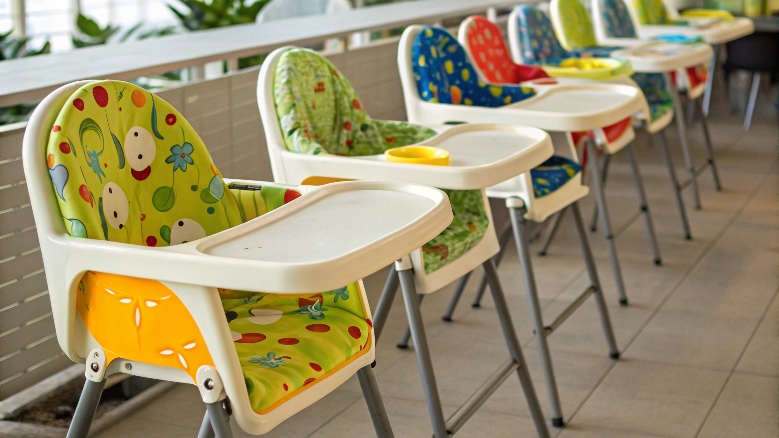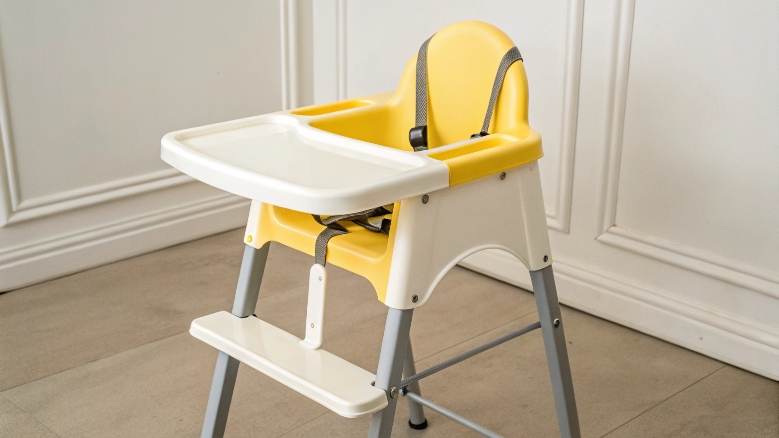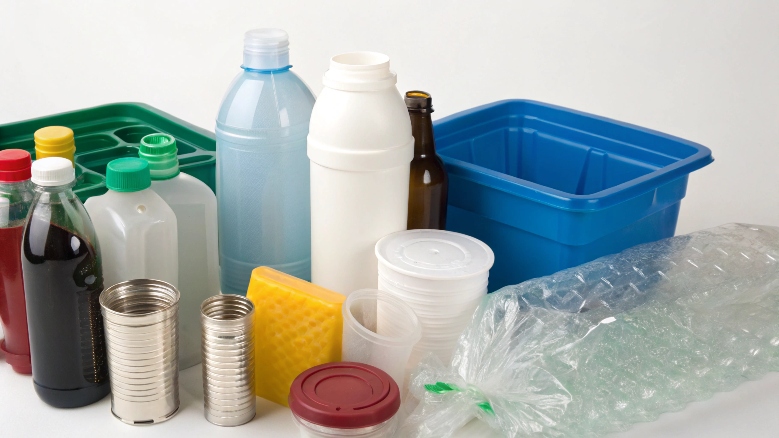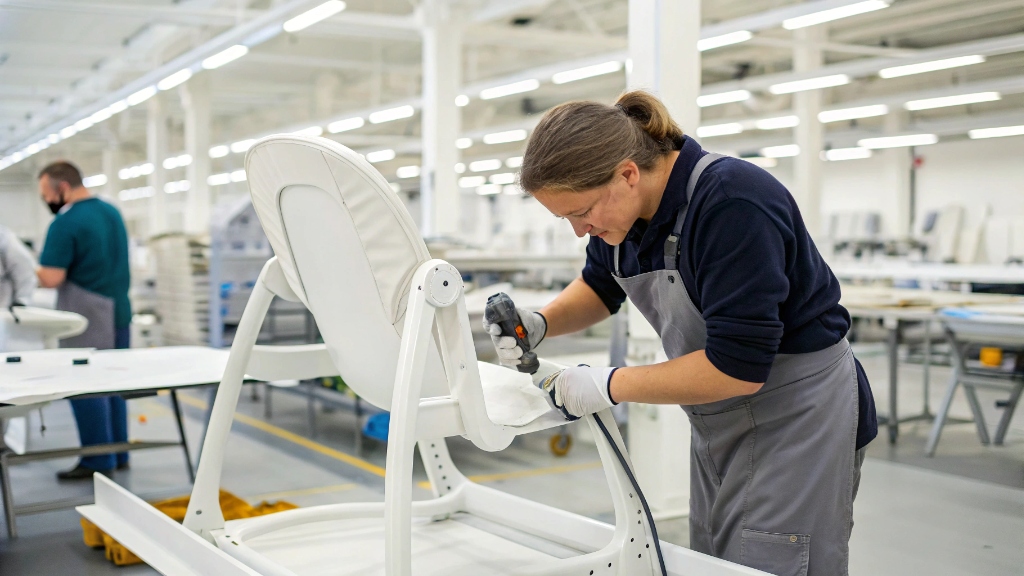Are you wondering what materials make up your child’s high chair? It is confusing to know if they are truly safe and durable for your little one. Understanding the common plastics used helps you choose wisely for your family.
Children’s high chairs commonly use several types of plastic, primarily Polypropylene (PP), High-Density Polyethylene (HDPE), and Acrylonitrile Butadiene Styrene (ABS). These plastics are chosen for their durability, ease of cleaning, and safety, often being free of harmful chemicals like BPA and phthalates.

When I first started looking for a high chair, I just saw plastic. I did not realize there were different kinds of plastic, each with its own traits. I learned that knowing about these materials is important. It affects how long the high chair lasts, how easy it is to clean, and most importantly, if it is safe for my child. So, let us look at what makes these plastics different.
What Are the Advantages and Disadvantages of Different Plastic Materials Used in High Chairs?
Are you confused about different plastic types in high chairs? Each plastic has its own strengths and weaknesses. Learning the pros and cons helps you pick the best high chair for your child.
Different plastic materials like Polypropylene (PP), High-Density Polyethylene (HDPE), and Acrylonitrile Butadiene Styrene (ABS) offer unique advantages and disadvantages in high chairs, affecting their durability, flexibility, appearance, and resistance to wear and tear over time.

I used to think plastic was just plastic. But when I began researching high chairs for my own child, I found out this was not true. Some plastics felt flimsy, others felt super strong. It really matters what kind of plastic a high chair is made from. This affects how well it holds up to daily spills, bumps, and constant cleaning. Knowing these differences helps me make a better choice for safety and lasting use.
Polypropylene (PP)
Polypropylene, often marked with a "5" recycling symbol, is one of the most common plastics found in high chairs. I see it used for many parts because it is very versatile. PP is known for its high strength-to-weight ratio, meaning it is strong but also quite light. It is resistant to many chemicals, which is a huge plus for high chairs. This chemical resistance means it handles frequent cleaning with household cleaners without breaking down or becoming brittle. It also resists impacts well. You will find PP in seats, trays, and even some frame components. A big advantage of PP is that it is generally considered safe for food contact, making it a good choice for trays where food spills happen often. It is also heat resistant, so it can handle warm food without deforming easily. The main downside I have noticed with PP is that it can become brittle over time if exposed to strong UV light, like direct sunlight, though this is less of an issue for indoor high chairs. It can also scratch more easily than some harder plastics.
High-Density Polyethylene (HDPE)
High-Density Polyethylene, identified by the "2" recycling symbol, is another frequent player in high chair construction. HDPE is often used for parts that need to be flexible but very strong, like the feet of the high chair or certain connecting joints. It is known for its excellent chemical resistance, similar to PP, and its resistance to cracking even at low temperatures. This makes it very durable. HDPE is also very easy to mold, allowing manufacturers to create complex shapes for safety and comfort. It is also considered food-safe, which is important for any part of a high chair that a baby might touch or put their mouth on. One of its key advantages is its great impact strength; it can take a lot of abuse without breaking. Compared to PP, HDPE is generally a bit softer and more flexible, which can be an advantage for shock absorption but means it might be more prone to scratching or dents if a harder object hits it.
Acrylonitrile Butadiene Styrene (ABS)
Acrylonitrile Butadiene Styrene, or ABS, is often used when a high chair needs to be particularly tough and rigid. You will find ABS in parts that need structural integrity, like the main frame, sturdy leg pieces, or even complex locking mechanisms. ABS is known for its outstanding impact resistance. This means it can withstand bumps, drops, and general rough handling without breaking. It also has good resistance to heat and chemicals, making it durable for a high-traffic item like a high chair. ABS gives products a high-quality, sometimes glossy finish, which looks nice and is easy to wipe clean. However, ABS is generally more expensive than PP or HDPE. It is also not typically used for direct food contact surfaces, so you will usually see it in the structural parts rather than the tray. Its rigidity means it is less flexible than HDPE, but this can be a benefit for parts needing to hold a specific shape under stress.
| Plastic Type | Recycling Symbol | Key Characteristics | Advantages (for High Chairs) | Disadvantages (for High Chairs) |
|---|---|---|---|---|
| PP | 5 | Strong, light, heat & chemical resist. | Durable, food-safe, easy to clean. | Can scratch, UV sensitive over time. |
| HDPE | 2 | Flexible, impact & chemical resist. | Very durable, safe, easy to mold. | Softer, might scratch more easily. |
| ABS | 7 (Other) | Very tough, rigid, impact resist. | High strength, good finish, impact-proof. | More expensive, less common for trays. |
How Can I Easily Distinguish Between Them?
How do you tell what plastic your high chair is made of? It is not always obvious, but knowing matters for safety and care. Simple tricks help you identify plastic types easily.
You can often distinguish between common high chair plastics by looking for recycling codes (numbers inside a triangle), feeling their texture and flexibility, or observing their general appearance, though specific identification often requires consulting the product’s manual.

When I got my high chair, I wanted to know exactly what it was made of. I knew that different plastics might have different cleaning needs or safety concerns, especially if my baby was going to be putting their mouth on it. It is not always easy, because plastics can look quite similar. But there are some simple methods I learned that can help. Knowing the type of plastic helps me understand its durability. It also helps me confirm if the material is free from harmful substances, like BPA or phthalates, which is always a top concern for any baby product.
Checking Recycling Codes
The easiest way to identify plastic types is to look for the recycling symbol. This is a triangle with a number inside it, usually molded into the plastic itself, often on the underside of a tray, a leg, or the main seat.
- Polypropylene (PP) is typically marked with a "5". If you find a "5" on your high chair part, it is likely made of PP.
- High-Density Polyethylene (HDPE) is usually marked with a "2". This is common for parts that need to be a bit more flexible.
- Acrylonitrile Butadiene Styrene (ABS) is often marked with a "7" (which stands for "Other") or sometimes a "9" if it’s a blended plastic. ABS is not assigned its own unique number because it is a more specialized plastic.
Manufacturers are usually good about including these codes, as it aids in recycling and material identification. If you cannot find a number, check the product manual or the manufacturer’s website. They usually list the materials used.
Visual and Tactile Clues
Beyond the recycling codes, you can often get clues from how the plastic looks and feels.
- Polypropylene (PP): When you touch PP, it often feels a bit waxy or slippery. It can have a slightly matte or glossy finish depending on how it is molded. When you try to bend a thin piece of PP, it will be flexible but usually snaps back into shape without breaking. It often makes a slightly dull sound when tapped.
- High-Density Polyethylene (HDPE): HDPE often feels a bit softer or more pliable than PP, especially in thinner sections. It can sometimes have a slightly milky or opaque appearance if it is not dyed a solid color. It is very flexible and hard to break by bending, making it feel very durable and tough. When tapped, it might have a slightly softer, less resonant sound than PP.
- Acrylonitrile Butadiene Styrene (ABS): ABS parts often look more rigid and have a hard, smooth, sometimes shiny surface finish. When you tap ABS, it typically makes a sharp, solid sound. It does not feel flexible like HDPE or as waxy as PP. It will feel very stiff and strong, much like the plastic used in LEGO bricks (which are also made of ABS). If you try to flex a piece, it will resist bending much more than PP or HDPE.
These are general observations. Remember that plastic formulations can vary, and manufacturers often add colors or textures that can mask these natural characteristics. So, always rely on the recycling code or manufacturer information first.
| Plastic Type | Common Recycling Code | Visual Appearance | Tactile Feel (Touch) | Flexibility (bending) | Sound (when tapped) |
|---|---|---|---|---|---|
| PP | 5 | Varies (matte/glossy), often uniform. | Slightly waxy, smooth, slightly soft. | Flexible but snaps back. | Dull or soft thud. |
| HDPE | 2 | Can be translucent/milky, or solid. | Softer, more pliable, slightly greasy. | Very flexible, hard to break by bending. | Softer, less resonant. |
| ABS | 7 (or no code) | Hard, rigid, often glossy or textured. | Hard, very smooth, solid. | Very rigid, resists bending strongly. | Sharp, solid, resonant. |
Conclusion
High chairs use Polypropylene, HDPE, and ABS plastics. Each offers unique pros and cons for durability and safety. Check recycling codes or physical traits to identify them.





